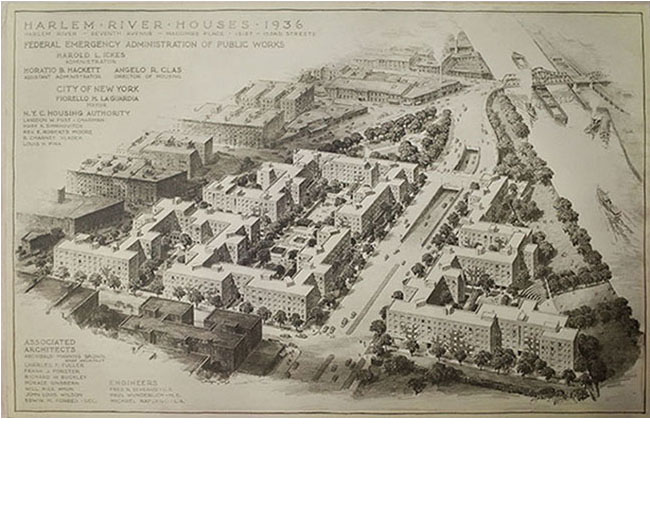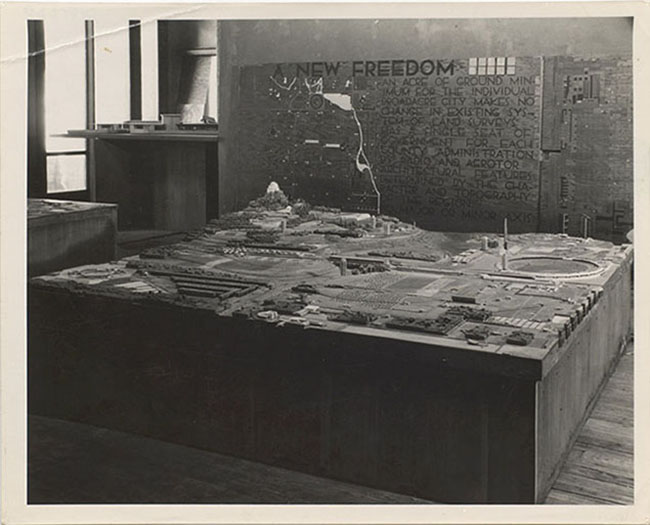Living in America: Frank Lloyd Wright, Harlem, and Modern Housing
September 9- December 17, 2017


"Living in America," part of a manifesto that was written on wooden panels traveling with the model of Frank Lloyd Wright's Broadacre City (1929–58), evokes a question that preoccupied architects and planners throughout the mid-twentieth century. Wright's idealized plan for an exurban settlement of single-family homes offered one possible answer; plans for large public or subsidized housing located in urban areas presented another. Although these two visions seem a world apart, they share a common history.
Wright (1867–1959) first exhibited his Broadacre City project at Rockefeller Center in midtown Manhattan in 1935. While the prominent, Wisconsin-based architect anticipated a degree of economic diversity, Broadacre's residents were, for the most part, implicitly white. In 1936 construction began on one of New York City's first public housing developments, the Harlem River Houses, funded by the Public Works Administration under President Franklin D. Roosevelt's New Deal. Built for working-class African Americans, the complex was designed by a consortium including John Louis Wilson, Jr., the first African American to graduate from Columbia University's School of Architecture. Through such parallel examples, this exhibition tells a story of segregation, inequality, and aspiration––a story as old as the country itself, and one that continues to pose the question, "How to live in America, together?"
The exhibition's narrative takes the form of two interwoven plotlines, developed through displays of project-specific drawings, photographs, and other material dating from the late 1920s to the late 1950s. One plotline tracks the Broadacre scheme as it plays out in Wright's subsequent work, scattered around the country; the other tracks the development of public housing in Harlem, ending just outside the gallery, adjacent to Columbia's new campus. Both stories connect social institutions, such as the nuclear family, with economic structures, such as private property or its alternatives. In Wright's incompletely realized "American Dream" of exurban living we witness lines of race, class, and gender being drawn. Harlem's public housing complexes draw similar lines. They also, however, acknowledge a right—the right to housing—that is actively forgotten in America today.
Living in America has been curated by The Temple Hoyne Buell Center for the Study of American ArchitectureThe Temple Hoyne Buell Center for the Study of American Architecture at Columbia University’s Graduate School of Architecture, Planning, and Preservation (GSAPP), and is co-presented by The Buell Center, The Miriam and Ira D. Wallach Art Gallery, and Avery Architectural and Fine Arts Library. The exhibition is presented in correlation with Frank Lloyd Wright at 150: Unpacking the Archive, on view at The Museum of Modern Art, New York, from June 12 through October 1, 2017. “Broad Acres and Narrow Lots,” an associated essay by David Smiley, Assistant Director of the Urban Design Program at Columbia GSAPP, is included in the MoMA exhibition catalogue. Living in America’s curatorial team is composed of students from various Columbia University masters and doctoral programs together with the Center staff and in close collaboration with archivists from the Avery Architectural and Fine Arts library and other institutions.
The Buell Center research team includes: Reinhold Martin, Director; Jacob Moore, Assistant Director; and Jordan Steingard, Program Manager; together with Erik Carver (Harlem Team Leader), Daniel Cooper, Clara Dykstra, Robin Hartanto Honggare, Neha Krishnan, Tola Oniyangi, Julie Pedtke, Jiexi Qi, Alexander Hilton Wood (Frank Lloyd Wright Team Leader), Ashley Wu, and Zhengyang (Echo) Yue.
The exhibition design team includes: Project Projects: Shannon Harvey, Prem Krishnamurthy, Lauren Bishop, Janet Chan, Chris Wu; and Leong Leong: Dominic Leong, Gabriel Burkett.
Archival material has been drawn from: Avery Architectural & Fine Arts Library, Columbia University; Columbia University Archives; Cornell University Library, Rare and Manuscript Collections; Dwight D. Eisenhower Presidential Library; Frank Lloyd Wright Foundation Archive (The Museum of Modern Art | Avery Architectural & Fine Arts Library, Columbia University, New York); Hagley Museum and Library; The LaGuardia and Wagner Archives, Fiorello H. LaGuardia Community College/CUNY; The Library of Congress; The Museum of the City of New York; The National Archives; New York City Municipal Archives; The New York City Housing Authority; Rockefeller Archive Center; Schomburg Center for Research in Black Culture; Syracuse University Library, Special Collections Research Center; University of Massachusetts at Amherst, DuBois Archive; Wayne State University, Walter P. Reuther Library; The Wisconsin Historical Society.RELATED EVENTS
Living in America: Symposium
Date: September 29
Time: 10 am - 5:30 pm
Location: The Lantern (8th floor)
at Lenfest Center for the Arts
615 W. 129th St
(Enter on W. 125th Street, just west of Broadway)
For more information and to register click here.
Public Housing Today: Forum
Date: November 1
Time: at 6 pm
Location: The Lantern (8th Floor)
at Lenfest Ceter for the Arts
The current challenges facing New York City public housing are assessed from multiple perspectives.
Participants:
Quardean Lewis-Allen, Founder and CEO, Made in BrownsvilleVictor Bach, Senior Housing Policy Analyst, Community Service Society
Jae Shin, Rose Architectural Fellow, NYCHA
Gallery Talks
Experience Living in America: Frank Lloyd Wright, Harlem and Modern Housing from a variety of perspectives at these Saturday afternoon presentations.
Date: October 21
Time: 1:00 pm
Harlem residents Ashley Arias, Roger Parris and Ralph E. Waiters share their poetry, which reflects their life experiences in Harlem.
Date: November 4
Time: 1:00 pm
Join Living in America exhibition designers, Gabriel Burkett, Leong Leong and Chris Wu, Project Projects for a discussion about the installation.
Date: December 2
Time: 1:00 pm
With Mario Gooden, Professor of Practice, Co-Director, Global Africa Lab, Graduate School of Architecture Planning & Preservation, Columbia University and Damon Rich, Hector Urban Design, Planning, and Civic Arts Studio.
All talks meet at the Wallach Art Gallery entrance on the sixth floor of the Lenfest Center for the Arts.
The Temple Hoyne Buell Center for the Study of American Architecture at Columbia University was founded in 1982. Its mission is to advance the study of American architecture, urbanism, and landscape. Located within the Graduate School of Architecture, Planning, and Preservation at Columbia University, it sponsors program and research projects focusing on issues of both scholarly and general interest.
Founded in 1890, the Avery Architectural and Fine Arts Library collects books and periodicals in architecture, historic preservation, art history, painting, sculpture, photography, decorative arts, city planning, real estate, and archaeology. The scope of the Avery collection in architecture is outstanding; it ranges from the first Western printed book on architecture, De re aedificatoria(1485), by Leone Battista Alberti, to the classics of modernism by Frank Lloyd Wright and Le Corbusier. Avery's drawing and archives collection holds approximately 1,500,000 drawings and original records.


